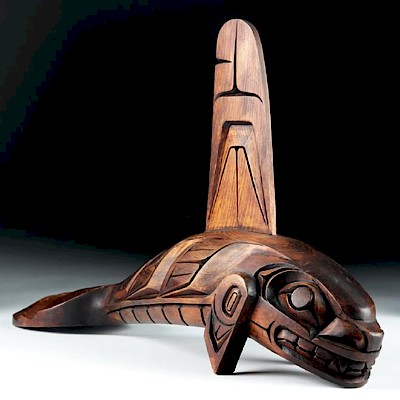Veracruz Nopiloa Pottery Bottle in Frog Form
Lot 110
About Seller
Artemis Fine Arts
686 S Taylor Ave, Ste 106
Louisville, CO 80027
United States
Selling antiquities, ancient and ethnographic art online since 1993, Artemis Gallery specializes in Classical Antiquities (Egyptian, Greek, Roman, Near Eastern), Asian, Pre-Columbian, African / Tribal / Oceanographic art. Our extensive inventory includes pottery, stone, metal, wood, glass and textil...Read more
Estimate:
$1,800 - $2,500
Absentee vs Live bid
Two ways to bid:
- Leave a max absentee bid and the platform will bid on your behalf up to your maximum bid during the live auction.
- Bid live during the auction and your bids will be submitted real-time to the auctioneer.
Bid Increments
| Price | Bid Increment |
|---|---|
| $0 | $25 |
| $300 | $50 |
| $1,000 | $100 |
| $2,000 | $250 |
| $5,000 | $500 |
| $10,000 | $1,000 |
| $20,000 | $2,500 |
| $50,000 | $5,000 |
| $100,000 | $10,000 |
| $200,000 | $20,000 |
About Auction
By Artemis Fine Arts
May 24, 2018
Set Reminder
2018-05-24 10:00:00
2018-05-24 10:00:00
America/New_York
Bidsquare
Bidsquare : Northwest Coast, Tribal, & Pre-Columbian Art
https://www.bidsquare.com/auctions/artemis-gallery/northwest-coast-tribal-pre-columbian-art-3238
Featuring Pacific Northwest Coast Native American Art from respected collector / dealer, Joseph Alphabet. Artemis Fine Arts info@artemisfinearts.com
Featuring Pacific Northwest Coast Native American Art from respected collector / dealer, Joseph Alphabet. Artemis Fine Arts info@artemisfinearts.com
- Lot Description
Pre-Columbian, Gulf Coast Mexico, Veracruz, ca. 700 to 900 CE. An amusing, mold-formed pottery poison bottle in the form of a smiling frog, shown squatting with delineated male genitalia between his legs. The rotund body sports a large encircled central medallion and a leafy necklace, with arms raised towards a pair of flowing locks extending from its head. The stylized visage sports round eyes and arching eyebrows, a sloping nose, a wide smile, and a planar brow. Scattered areas across the body are accentuated with bright "Maya blue" and coral-red pigment, which nicely complement the creamy beige hue of the body. The verso is comprised of a bulbous vessel wall with a circular spout ringed in a red hue on top. Examples like this were meant to contain poisonous substances that were applied to arrows or knives just before use. A beautiful and rare example! Size: 4.25" W x 4.25" H (10.8 cm x 10.8 cm).
Traditionally, items like this one have been known as "poison" or "medicine" bottles, in part because of their comparison to bottles used by other native North American groups, but depictions of people using the flasks in artwork as well as residue analysis on archaeological examples suggest that they may have had other uses. They are often found in the context of burials, filled with red pigment like cinnabar or hematite, but with the remains of other things underneath the pigment (as if they were used in life and then filled with color in death).
What is the meaning of this fabulous vessel? Much of the religious practice of this culture and others in Mesoamerica involved shamans/priests entering an altered mental state, often through the use of strong alcohol or hallucinogenic drugs. Once in that trance-like state, they would become someone different. The highly-detailed amphibious form as well as the overall size of this example suggests that this was meant to hold copious quantities of liquids or other substances.
For a similar example of this overall form, please see the Los Angeles County Museum of Art, accession number M.90.168.26: https://collections.lacma.org/node/178263
Provenance: private Hawaii, USA collection; ex-Robert Huber collection, New York, USA
All items legal to buy/sell under U.S. Statute covering cultural patrimony Code 2600, CHAPTER 14, and are guaranteed to be as described or your money back.
A Certificate of Authenticity will accompany all winning bids.
We ship worldwide and handle all shipping in-house for your convenience.
#133792Vessel repaired from multiple pieces with some restoration, overpainting, and resurfacing along break lines. Surface wear commensurate with age, small nicks to face, vessel rim, and base, fading to coloration, and some discoloration to body. Light earthen deposits throughout.Condition
- Shipping Info
-
All shipping is handled in-house for your convenience. Your invoice from Artemis Gallery will include shipping calculation instructions. If in doubt, please inquire BEFORE bidding for estimated shipping costs for individual items.
-
- Buyer's Premium



 EUR
EUR CAD
CAD AUD
AUD GBP
GBP MXN
MXN HKD
HKD CNY
CNY MYR
MYR SEK
SEK SGD
SGD CHF
CHF THB
THB

















